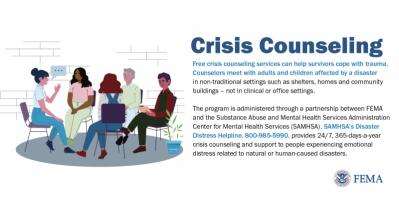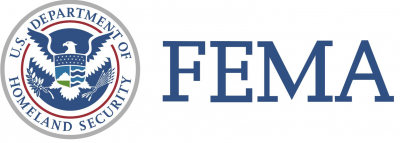FEMA Assistance and Other Resources
Floridians who have been impacted by Hurricane Ian may be eligible for FEMA grants for temporary lodging or rental assistance if home is deemed uninhabitable by the storm. May also be eligible for basic home repairs, personal property losses, and other eligible expenses. Applications for disaster assistance can be completed by calling 800-621-3362 between 7:00 AM to 11:00 PM EST or visiting www. disasterassistance.gov or through the FEMA mobile app (Google Play or Apple Store). Applicants must apply for assistance within 60 days of the disaster declaration. When you apply for assistance, have the following information ready:
- A current phone number where you can be contacted
- Your address at the time of the disaster and the address where you are now staying
- Your Social Security number
- A general list of damage and losses
- Banking information if you choose direct deposit
- If insured, the policy number or the agent and/or the company name
Important to note: FEMA is a stop gap for folks who are left without any coverage. What does this mean? When you register with FEMA and apply for assistance, you will have to declare your insurance coverage (if any) and you will be screened to determine if you qualify for a low-interest Federal loan through the Small Business Association (SBA) or a grant from FEMA. Representatives of FEMA have started to go door-to-door in the hardest hit areas, and it is very important to look for the FEMA identifying badge and the FEMA logo on their clothing
How to Appeal FEMA’s Decision If you receive a letter from FEMA saying you are ineligible for assistance, you can appeal the decision and provide more information. For information of how to file an appeal within 60 days of denial visit: https://www.fema.gov/fact-sheet/how-appeal-femas-decision
FEMA is meeting survivors where they are to help jumpstart their recovery. Along with Disaster Survivor Assistance specialists going door-to-door in Florida neighborhoods to help individuals register for assistance, survivors can visit one of the 11 Disaster Recovery Centers operating across the state. Interpretation services and translated materials are available at these centers to help survivors communicate in the language they feel most comfortable. Disaster Recovery Center locations are chosen for their accessibility, with the goal of reaching as many people as possible. As centers are added, real-time locations will be updated at FloridaDisaster.org.
FEMA Disaster Recovery Center in Collier County
Veterans Community Park
1895 Veterans Park Drive, Naples 34109
Hours of operation: 9 a.m. to 6 p.m. daily until further notice
FEMA will pay hotel and motel costs for eligible survivors. FEMA and the state of Florida activated the Transitional Shelter Assistance Program, which allows FEMA to make payments directly to participating hotels and motels in Alabama, Florida and Georgia that provide emergency shelter to survivors. As of today, the program is providing housing for 842 households with 2,184 members.
Disaster Unemployment Assistance is available to eligible survivors. Floridians should file a claim for loss of income caused by Hurricane Ian by going to Disaster Unemployment Assistance - FloridaJobs.org and selecting “Apply for Hurricane Ian DUA,” visiting a local CareerSource Career Center, or calling 800-385-3920. Customer service representatives are available Monday through Friday, 7:30 a.m. to 6:30 p.m. ET.
Low-income Florida residents recovering from Hurricane Ian may be eligible for assistance from the Department of Agriculture’s Disaster Supplemental Nutrition Assistance Program (D-SNAP). Survivors can find more information on Florida’s D-SNAP program by visiting the Florida Department of Children and Families’ Hurricane Ian Response & Recovery website.
Visit www.myflfamilies.com/hurricaneian/ for information and resources on the Disaster Supplemental Nutrition Assistance Program (D-SNAP), Food Replacement, Food Assistance, Family Resources Support Center, and much more.
FEMA Home Inspections
When a household applies for FEMA assistance, FEMA may need to verify disaster-caused damages and disaster-related losses for some categories and items.
To get assistance to households more quickly, FEMA is using both in-person inspections and other methods such as geospatial information from satellite images, post-storm photos taken from the air, flood data and assessments made by search teams.
If an in-person inspection is required, FEMA will contact the applicant, schedule the inspection and walk through the home with the applicant to verify damage. If the applicant does not want an internal inspection because of Covid and/or other safety concerns, an exterior inspection can be performed and the applicant can provide information to the inspector about interior damage.

After a disaster, people who experience displacement, property damage, or other losses may be at risk for distress or other mental health concerns. You're not alone: the disaster distress helpline 1-800-985-5990 offers 24/7 emotional support. Deaf and hard of hearing ASL callers can use a videophone or ASL Now.
Learn more: click here
Operation Blue Roof program is a free service to homeowners. Residents can sign up at Blueroof.us. A Right of Entry (ROE) form must be completed. Residents can call 1-888-ROOF-BLU (766-3258) for more information.
Free Legal Assistance Available for Florida Ian Survivors - view information here

